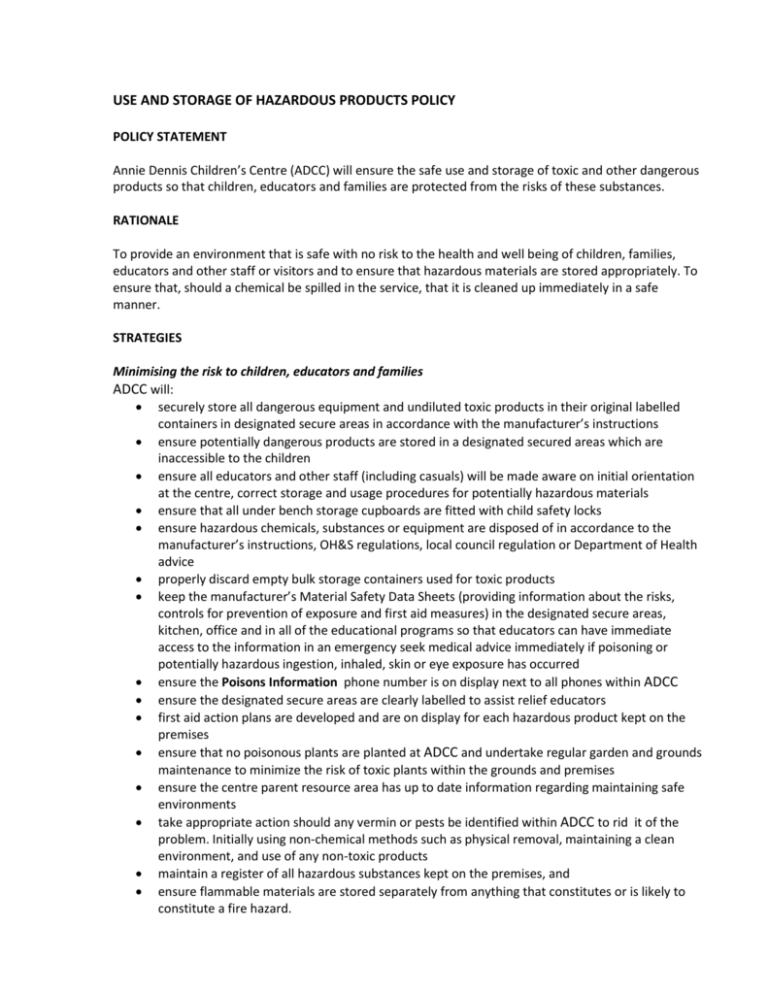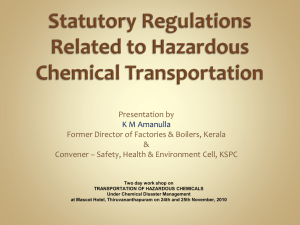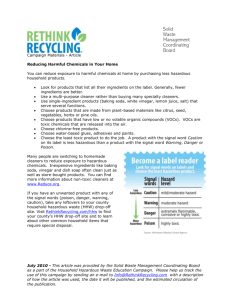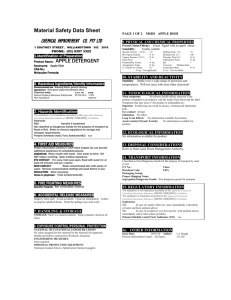ADCC Hazardous Products Policy - Annie Dennis Children`s Centre
advertisement

USE AND STORAGE OF HAZARDOUS PRODUCTS POLICY POLICY STATEMENT Annie Dennis Children’s Centre (ADCC) will ensure the safe use and storage of toxic and other dangerous products so that children, educators and families are protected from the risks of these substances. RATIONALE To provide an environment that is safe with no risk to the health and well being of children, families, educators and other staff or visitors and to ensure that hazardous materials are stored appropriately. To ensure that, should a chemical be spilled in the service, that it is cleaned up immediately in a safe manner. STRATEGIES Minimising the risk to children, educators and families ADCC will: securely store all dangerous equipment and undiluted toxic products in their original labelled containers in designated secure areas in accordance with the manufacturer’s instructions ensure potentially dangerous products are stored in a designated secured areas which are inaccessible to the children ensure all educators and other staff (including casuals) will be made aware on initial orientation at the centre, correct storage and usage procedures for potentially hazardous materials ensure that all under bench storage cupboards are fitted with child safety locks ensure hazardous chemicals, substances or equipment are disposed of in accordance to the manufacturer’s instructions, OH&S regulations, local council regulation or Department of Health advice properly discard empty bulk storage containers used for toxic products keep the manufacturer’s Material Safety Data Sheets (providing information about the risks, controls for prevention of exposure and first aid measures) in the designated secure areas, kitchen, office and in all of the educational programs so that educators can have immediate access to the information in an emergency seek medical advice immediately if poisoning or potentially hazardous ingestion, inhaled, skin or eye exposure has occurred ensure the Poisons Information phone number is on display next to all phones within ADCC ensure the designated secure areas are clearly labelled to assist relief educators first aid action plans are developed and are on display for each hazardous product kept on the premises ensure that no poisonous plants are planted at ADCC and undertake regular garden and grounds maintenance to minimize the risk of toxic plants within the grounds and premises ensure the centre parent resource area has up to date information regarding maintaining safe environments take appropriate action should any vermin or pests be identified within ADCC to rid it of the problem. Initially using non-chemical methods such as physical removal, maintaining a clean environment, and use of any non-toxic products maintain a register of all hazardous substances kept on the premises, and ensure flammable materials are stored separately from anything that constitutes or is likely to constitute a fire hazard. The educators will: choose the least hazardous product for the job ensure that all cleaning products are diluted in the laundry in accordance with manufacturer’s instructions ensure cleaning products and aids are be stored in above storage/shelves cupboards ensure that the laundry and outdoor storeroom are secure at all times and they do not inadvertently provide access for children to the items stored there ensure all cleaning products in their educational programs are stored safely and made inaccessible to children at all times ensure chemicals used to clean tables and equipment are in spray or squeeze bottles and must be clearly labelled with contents ensure any cupboards/shelf with dangerous chemicals must have a sign stating chemicals stored always read the label before use of any cleaning material, sprays or chemicals and be aware of appropriate first aid measures only administer children’s medications with family authorisation and in accordance with medical directions. All medications will be stored in medication cabinets inaccessible to children. If any medications or dangerous substances require refrigeration, they must be placed in a labelled childproof container, preferably in a separate compartment of the fridge ensure cleaning and hazardous products are not be stored close to food products, and seek medical advice as needed by contacting the Poisons Information Line – 13 11 26 or by calling 000. The OH&S representative will ensure the following are up to date: Material Safety Data Sheets – with a review of the folder annually. No SDS is to be more than 5 years old dangerous chemical signs first aid action plans, and register of all hazardous substances kept on the premises. The OH&S representative will conduct and record regular a bi annual audit of toxic or dangerous products (appendix A). Hazardous Cleaning Products ADCC will purchase and use less toxic substances whenever possible, while maintain the highest level of hygiene standards. ADCC uses the following cleaning products: dishwashing detergent laundry powder creme cleanser nappy soaking powder (soaking bibs and towels) household bleach (during gastroenteritis outbreaks) spray sanitiser ( food preparation areas). LINKS TO OTHER POLICIES Incident, Injury, Trauma, Illness and First Aid Emergency and Evacuation OH& and Wellbeing Food Safety Building, Environment, Equipment and Safety Checks Hygiene Supervision of Children Administration of Medication LEGISLATION Education and Care Services National Law Act 2010 (National Law) - Part 6, Operating an education and care service Health Act 1958 Education and Care Services National regulations 2012 (National Regulations) 77, 85, 103, 120, 151 Health Records Act 2001 The Occupational Health and Safety Act 2004 The Occupational Health and Safety (Hazardous Substances) Regulations 1999 Dangerous Goods (Storage and Handling) Regulations 2000 LINK TO NATIONAL QUALITY STANDARDS The Hazardous Products policy is linked to the National Quality Standards, National Law and National Regulations Quality Area 2: Children’s health and safety- This quality area of the National Quality Standard focuses on safeguarding and promoting children’s health and safety. Standard 2.1 Element 2.1.4 Standard 2.3 Element 2.3.2 Quality Area 7: Leadership and Service Management- This quality area of the National Quality Standard focuses on effective leadership and management of the service that contributes to quality environments for children’s learning and development. Well-documented policies and procedures, well-maintained records, shared values, clear direction and reflective practices enable the service to function as a learning community. An ongoing cycle of planning and review, including engagement with families, creates the climate for continuous improvement. Standard 7.3 Element 7.3.2, 7.3.5 SOURCES A Step By Step Guide For Chemicals Management In The Workplace http://www.worksafe.vic.gov.au/__data/assets/pdf_file/0018/60075/Managing_chemicals_in_Workplac e.pdf National Health and Medical Research Council (NHMRC), Staying Healthy in Childcare 5th Edition 2012. Date February 2013 Approval 16 September 2013 Next review date September 2015










